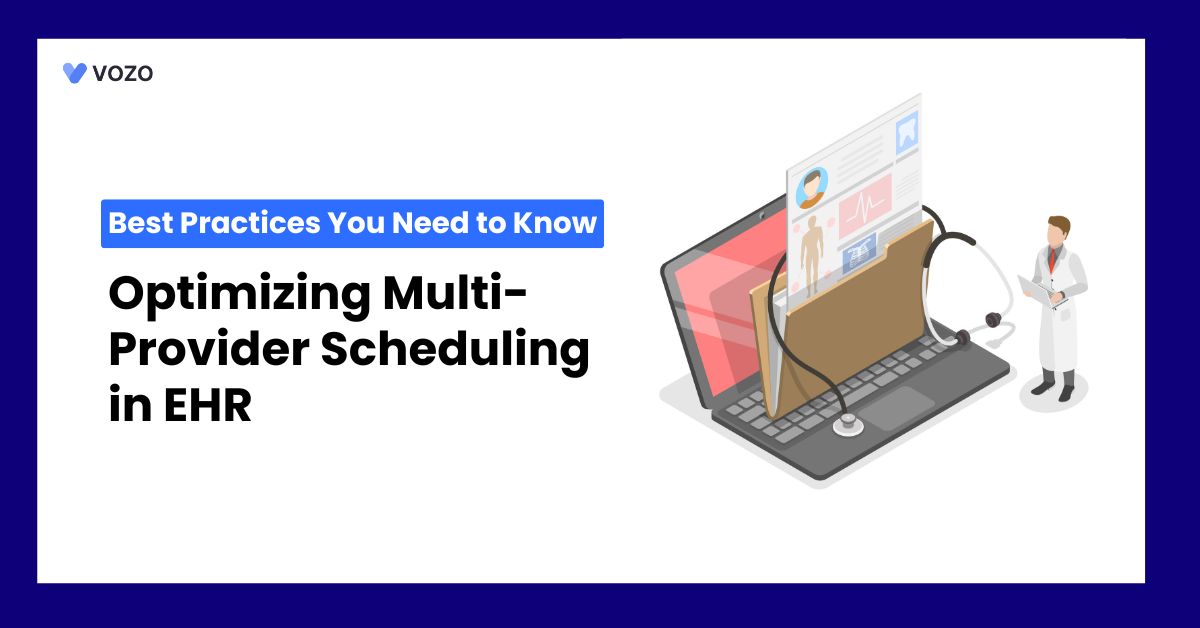Optimizing Multi-Provider Scheduling in EHR: Best Practices You Need to Know
Scheduling plays a critical role in healthcare, ensuring provider availability, optimal resource utilization, reducing patient wait times, and improving overall workflow efficiency.
However, multi-provider scheduling in Electronic Health Record systems uniquely has some challenges, which include appointment overlaps, provider availability conflicts, and patient no-shows.
In this blog, we’ll explore the challenges in multi-provider scheduling and the best practices for multi-provider scheduling in EHR that help healthcare organisations enhance their operational efficiency.
Benefits of Optimized Scheduling
1. Improved Efficiency
Appointment scheduling systems ease the process of booking appointments across multiple providers and locations, reducing the manual tasks and errors. Multi-Provider Scheduling allows healthcare providers to allocate better resources for patients.
Multi-Provider scheduling helps administrative staff spend less time organising appointments, which improves communication between providers, staff, and patients, resulting in reduced misunderstandings.
2. Enhanced Provider Productivity
Centralised systems allow access to patient information, thus improving the efficiency of appointments. Staff can focus on patient care as they spend less time on scheduling tasks. Providers can manage their time better according to their work schedule.
3. Data analytics
The Centralised System provides data on appointments scheduled, resources allocated, and other key metrics that allow providers to optimise their appointments and improve their workflow.
Data analytics and reports help healthcare providers find the pattern of scheduled appointments and implement steps for staffing, resource allocation.
Related: The Importance of Adapting Online Appointment Scheduling System in Healthcare
Challenges in Multi-Provider Scheduling
1. Overlapping Appointments
Sometimes patients need to schedule an appointment with multiple healthcare providers, such as therapists, primary care providers, for detailed treatment plans. Scheduling appointments across providers and locations can be time-consuming, complex lead to provider conflicts.
2. Provider Availability
Demand for patient appointments varies based on time, day of the week, and priority of the case. Providers might have availability issues and find it challenging to meet the patient’s needs. Efficient scheduling is required for optimising healthcare resources, which includes staff time and equipment usage.
3. Managing Cancellations
Cancelling scheduled appointments can disturb the process and waste the allocated resources for the patients. Cancellations create gaps in the scheduling system and require rescheduling. No-shows can impact patient care, particularly high-priority cases.
4. Timely Access to Patient Care
Long wait times for appointments create patient dissatisfaction. Patients who need immediate care face difficulties due to provider unavailability. They need to consider locations, providers while scheduling appointments.
Related: 6 Ways to Make EHR Appointment Scheduling Process More Efficient
Best Practices for Multi-Provider Scheduling
1. Scheduling System
A Centralised System helps in efficient coordination among multiple healthcare providers and various locations. This scheduling system reduces errors and conflicts between providers.
The EHR system offers online scheduling, self-scheduling options, and different appointment dates and time slots. This makes the scheduling process easier.
The system allows scheduling, checking the availability of the providers, and booking appointments. There are flexible scheduling options based on patient preferences, which help to improve patient attendance.
2. Automated Reminders
Automated reminders reduce no-show time and last-minute cancellations. Automated reminders are sent via SMS, email to remind patients, which helps them avoid missing appointments. It increases time spent with healthcare providers, enhances patient presence, and streamlines hospital operations.
3. AI-Driven Analytics
Predictive analytics helps to streamline appointment allocation. Real-time data prevents double booking and ensures schedule accuracy.
4. Optimise Staff Utilization
Scheduling software allows tracking staff and provider availability and scheduling appointments. This allows staff to minimise downtime and ensure staff are available when needed.
Related: The Best Practices for Patient Appointment Scheduling with EHR
Vozo Cloud EHR for your Medical Practice
If you are searching for the best EHR system for your healthcare practice, Vozo EHR can be your go-to choice. Our comprehensive EHR solution lets you focus more on patient care while carrying all the burdens and simplifying them.
- Vozo Cloud EHR’s cost-effective cloud subscription benefits all levels of practice.
- Our feature-rich EHR helps you rectify mistakes efficiently and speed up the process.
- Vozo Specialty EHR resonates with specialty practice needs and requirements.
- Our expert technical team gets you covered 24/7 if any needs arise.
- Our EHR System continues to scale as your healthcare practice grows to improve the user experience.
The Vozo Customized EHR solution benefits your healthcare practice by:
- Streamlining the administrative process
- Improving workflow efficiency
- Reducing proneness to errors
- Manages all the patients’ records in one place
- Offers greater efficiency and cost savings across the board.
Our specialty-specific tools like scheduling, patient portals, lab integration, cloud hosting, and more meet the specific needs and requirements of your healthcare practice.
“Embrace Vozo EHR to Reduce Your Burdens and Enhance Patient Care”
About the author

With more than 4 years of experience in the dynamic healthcare technology landscape, Sid specializes in crafting compelling content on topics including EHR/EMR, patient portals, healthcare automation, remote patient monitoring, and health information exchange. His expertise lies in translating cutting-edge innovations and intricate topics into engaging narratives that resonate with diverse audiences.













